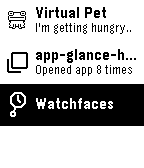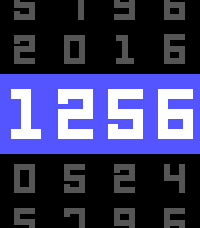A Wild SDK Appears
Developers rejoice - we’ve released the first version of our SDK 4 developer preview! This SDK enables you to start building applications for the new Diorite platform (Pebble 2), and includes a set of new APIs for interacting with the 4.0 user experience.
In this blog post we’ll dive into the App Glance,
UnobstructedArea, and
AppExitReason APIs, and explain
how you can use them to create great experiences for your users!
App Glance API
Let’s start with the App Glance API, which allows applications to present
information for the launcher to display. The information an application displays
in the launcher is called an app glance - and the information that is displayed
at any particular point in time is referred to as an AppGlanceSlice.

AppGlanceSlices have expiration times, which means you can add multiple slices
at once. Slices will be displayed in the order they are added and removed at
their specified expiration times.
static void prv_update_app_glance(AppGlanceReloadSession *session, size_t limit, void *context) {
// This shouldn't happen, but developers should always ensure they have
// sufficient slices, or adding slices may fail.
if (limit < 1) return;
// !! When layout.icon_resource_id is not set, the app's default icon is used
const AppGlanceSlice entry = (AppGlanceSlice) {
.layout = {
.template_string = "Hello from the app glance"
},
.expiration_time = APP_GLANCE_SLICE_NO_EXPIRATION
};
// Add the slice, and store the result so we can check it later
AppGlanceResult result = app_gpance_add_slice(session, entry);
}
To dig into this feature, we recommend you start with our new AppGlance C API guide, and also give the API docs a quick read.
We are planning to extend the AppGlance API to include a PebbleKit JS API, as well as a HTTP web API, intended to allow developers to push
AppGlanceSlices from external web services to their users' smartwatches.
UnobstructedArea API
The UnobstructedArea API
allows developers to create watchfaces capable of sensing, and responding to
Timeline Quick View events. Timeline Quick View is a new feature in SDK 4.0,
which displays upcoming and ongoing events on top of the user’s watchface. The
functionality added through the UnobstructedArea API allows developers to get
the unobstructed bounds of a layer, or subscribe to events related to the
watchface’s unobstructed area changing.
static int s_offset_top_percent = 33;
static int s_offset_bottom_percent = 20;
static void prv_unobstructed_change(AnimationProgress progress, void *context) {
// Get the total available screen real-estate
GRect bounds = layer_get_unobstructed_bounds(window_layer);
// Shift the Y coordinate of the top text layer
GRect top_frame = layer_get_frame(text_layer_get_layer(s_top_text_layer));
top_frame.origin.y = bounds.size.h * s_offset_top_percent / 100;
layer_set_frame(top_frame, text_layer_get_layer(s_top_text_layer));
// Shift the Y coordinate of our bottom text layer
GRect bottom_frame = layer_get_frame(text_layer_get_layer(s_bottom_text_layer));
bottom_frame.origin.y = bounds.size.h * s_offset_bottom_percent / 100;
layer_set_frame(bottom_frame, text_layer_get_layer(s_bottom_text_layer));
}
static void prv_main_window_load(Window *window) {
unobstructed_area_service_subscribe((UnobstructedAreaHandlers) {
.change = prv_unobstructed_change
}, NULL);
}
We encourage developers to begin exploring what their existing watchfaces will look like when the system is displaying the Timeline Quick View dialog, and adjust their designs to provide the best experience possible for users.
Take a look at our UnobstructedArea API Guide and the API documentation to get started!
AppExitReason API
One of the APIs we haven’t talked about as much is the
AppExitReason API, which enables
developers to specify why their app exited, and determines whether the system
returns the user to the launcher, or the active watchface. Take a look at our
AppExitReason API Guide,
and read the API docs to learn more.
This feature enables developers to create "One Click Action" watchapps, that perform an action, then immediately return the user to the watchface to create a simple, fluid experience.

To help get you started thinking about and designing One Click Action apps, we’ve created a One Click Action App Guide around the relatively minimal example of locking and unlocking your front door (with a Lockitron lock).
4.0 Emulator
The SDK 4 preview also includes an update to the emulator, which not only adds support for Pebble 2, but includes the updated 4.0 user interface, and a few other goodies that we’re sure developers will love.
The new emulator includes a launcher capable of displaying watchapps’ glances,
and can be accessed by pressing the Select button from the watchface.
CloudPebble and the Pebble Tool also include new functionality to enable developers to toggle Timeline Quick View, allowing you to make sure your watchface looks good in every context!
Finally, we’ve added the ability to install multiple watchfaces and watchapps
into the emulator. Watchfaces and watchapps installed into the emulator will
remain installed (even if the emulator is closed) until pebble wipe is called
from the command line.
Due to limitations with CloudPebble, this feature is currently only available in the Pebble Tool.
What’s Next
The SDK 4 developer preview is exactly that, a preview. You’ve probably noticed a few really important and exciting features we didn’t mention - the Heart Rate API has been designed, but is not yet fully implemented, and we have not yet added the ability to build applications for the Emery Platform (Pebble Time 2).
The official SDK 4 release is currently planned for the end of August - and it will include not only the Heart Rate API, and support for building Emery applications, but the first version of Pebble’s fantastic new embedded JavaScript SDK, Rocky.js.
Show Us What You Make
While we’ve been conceptualizing and designing the new functionality in SDK 4 for quite a long time, the API itself is relatively new, even for those of us lucky enough to ‘be on the inside’ - so we’ve only really just begun to see what’s possible, and we’re more than excited to see what you’ll build with this new functionality.
Send us a link to something you’ve built on Twitter ( @pebbledev) and we’ll look at including it in an upcoming newsletter (and send some swag your way).
Happy Hacking!
Team Pebble